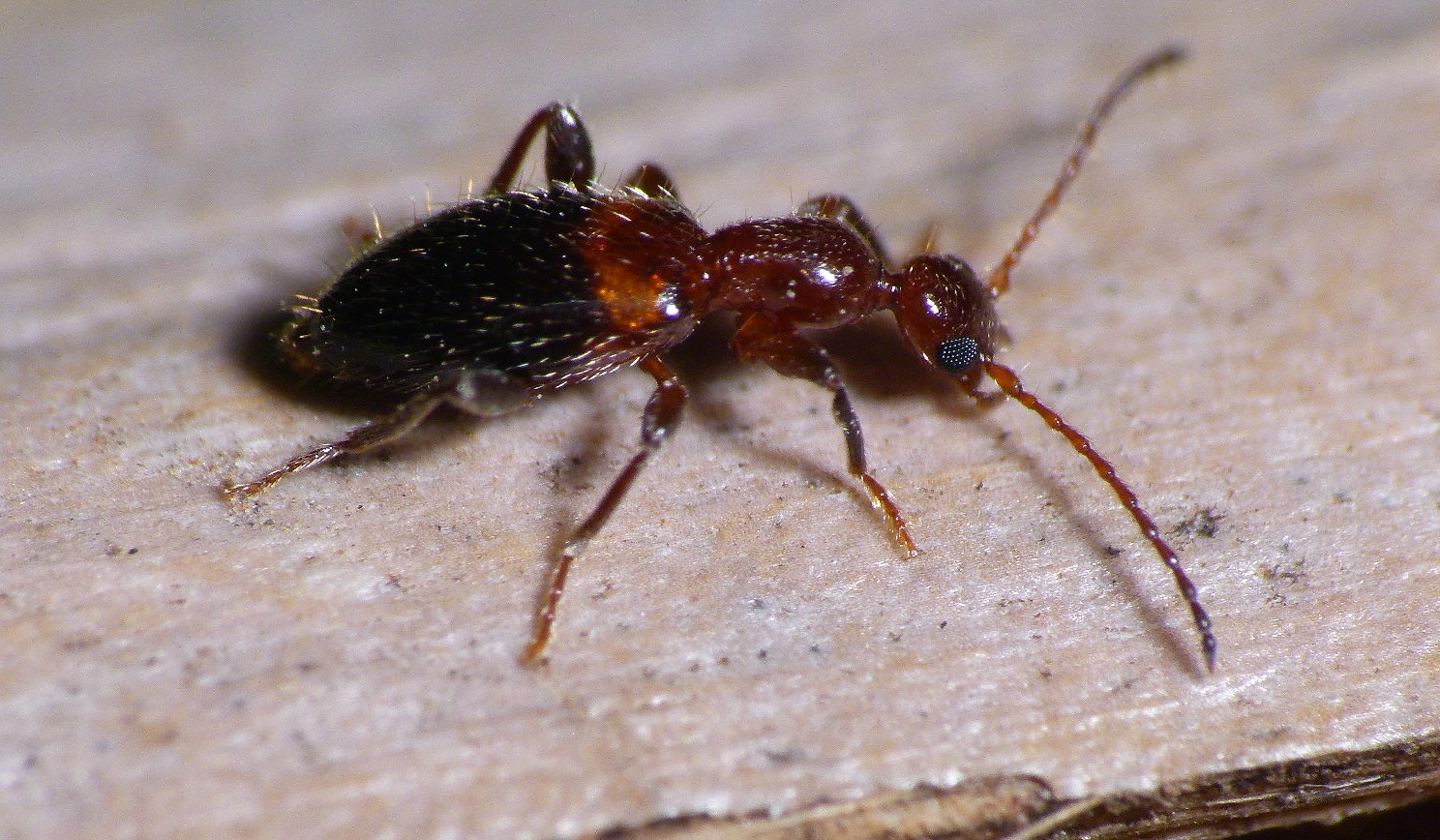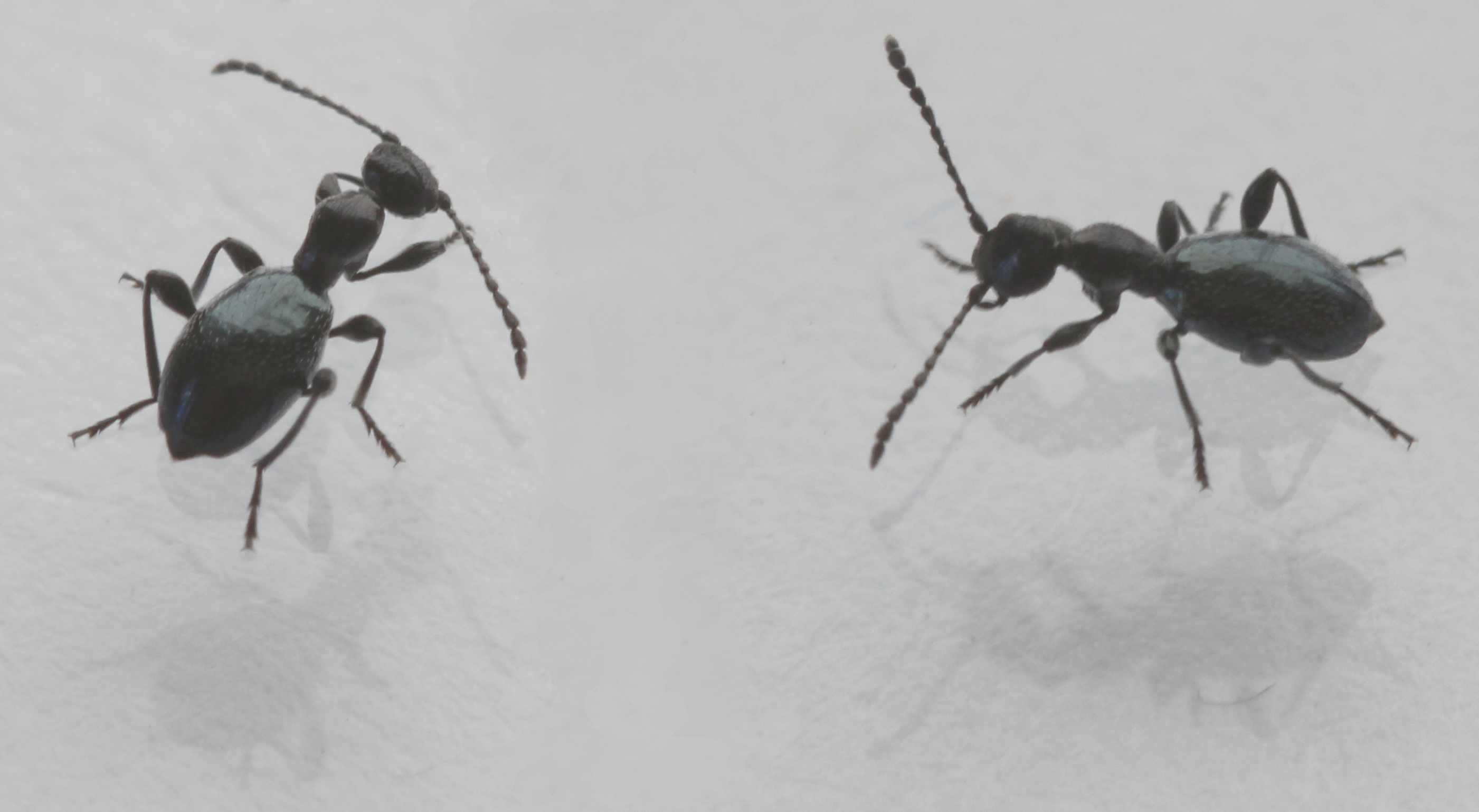Anthicidae on:
[Wikipedia]
[Google]
[Amazon]
The Anthicidae are a

 Their heads constrict just in front of the
Their heads constrict just in front of the
family
Family (from la, familia) is a Social group, group of people related either by consanguinity (by recognized birth) or Affinity (law), affinity (by marriage or other relationship). The purpose of the family is to maintain the well-being of its ...
of beetle
Beetles are insects that form the order Coleoptera (), in the superorder Endopterygota. Their front pair of wings are hardened into wing-cases, elytra, distinguishing them from most other insects. The Coleoptera, with about 400,000 describ ...
s that resemble ant
Ants are eusocial insects of the family Formicidae and, along with the related wasps and bees, belong to the order Hymenoptera. Ants evolved from vespoid wasp ancestors in the Cretaceous period. More than 13,800 of an estimated total of 22 ...
s. They are sometimes called ant-like flower beetles or ant-like beetles. The family comprises over 3,500 species in about 100 genera.
Description

 Their heads constrict just in front of the
Their heads constrict just in front of the pronotum
The prothorax is the foremost of the three segments in the thorax of an insect, and bears the first pair of legs. Its principal sclerites (exoskeletal plates) are the pronotum (dorsal), the prosternum (ventral), and the propleuron (lateral) on ea ...
, forming a neck, and the posterior end of the pronotum is usually narrow as well. Legs and antenna
Antenna ( antennas or antennae) may refer to:
Science and engineering
* Antenna (radio), also known as an aerial, a transducer designed to transmit or receive electromagnetic (e.g., TV or radio) waves
* Antennae Galaxies, the name of two collid ...
e are slender, heightening the ant-like appearance, and the body is sparsely covered with setae
In biology, setae (singular seta ; from the Latin word for "bristle") are any of a number of different bristle- or hair-like structures on living organisms.
Animal setae
Protostomes
Annelid setae are stiff bristles present on the body. Th ...
.
Biology
Adult beetles are omnivorous, being known to consume smallarthropod
Arthropods (, (gen. ποδός)) are invertebrate animals with an exoskeleton, a Segmentation (biology), segmented body, and paired jointed appendages. Arthropods form the phylum Arthropoda. They are distinguished by their jointed limbs and Arth ...
s, pollen
Pollen is a powdery substance produced by seed plants. It consists of pollen grains (highly reduced microgametophytes), which produce male gametes (sperm cells). Pollen grains have a hard coat made of sporopollenin that protects the gametophyt ...
, fungi
A fungus ( : fungi or funguses) is any member of the group of eukaryotic organisms that includes microorganisms such as yeasts and molds, as well as the more familiar mushrooms. These organisms are classified as a kingdom, separately from ...
, and whatever else they can find. Some species are of interest as biological control
Biological control or biocontrol is a method of controlling pests, such as insects, mites, weeds, and plant diseases, using other organisms. It relies on predation, parasitism, herbivory, or other natural mechanisms, but typically also invo ...
agents, as they can eat the eggs or larvae of pests. Larvae are either omnivorous, predators, or fungus-eaters; the young of one species of ''Notoxus
'' Notoxus monoceros''
''Notoxus'' is a large genus of beetles that resemble ants
Ants are Eusociality, eusocial insects of the Family (biology), family Formicidae and, along with the related wasps and bees, belong to the Taxonomy (biology) ...
'' have been observed boring into sweet potato
The sweet potato or sweetpotato (''Ipomoea batatas'') is a dicotyledonous plant that belongs to the Convolvulus, bindweed or morning glory family (biology), family, Convolvulaceae. Its large, starchy, sweet-tasting tuberous roots are used as a r ...
tubers.
Many members of the family are attracted to cantharidin
Cantharidin is an odorless, colorless fatty substance of the terpenoid class, which is secreted by many species of blister beetles. It is a burn agent or a poison in large doses, but preparations containing it were historically used as aphrodisiac ...
, which they seem to accumulate and that deters possible predators.
Taxonomy
Synonyms of the family include Notoxidae and Ischaliidae. The earliest known members of the family are from theEarly Cretaceous
The Early Cretaceous ( geochronological name) or the Lower Cretaceous (chronostratigraphic name), is the earlier or lower of the two major divisions of the Cretaceous. It is usually considered to stretch from 145 Ma to 100.5 Ma.
Geology
Pro ...
(Barremian
The Barremian is an age in the geologic timescale (or a chronostratigraphic stage) between 129.4 ± 1.5 Ma (million years ago) and 121.4 ± 1.0 Ma). It is a subdivision of the Early Cretaceous Epoch (or Lower Cretaceous Series). It is preceded ...
) aged Lebanese amber
Lebanese amber is fossilized resin found in Lebanon and southwest Syria. It dates back approximately 130-125 million years to the Barremian of the Early Cretaceous. It formed on what was then the northern coast of Gondwana, believed to be a tropica ...
, including '' Camelomorpha'' of the subfamily Macratriinae
Macratriinae is a subfamily of antlike flower beetles in the family Anthicidae
The Anthicidae are a family of beetles that resemble ants. They are sometimes called ant-like flower beetles or ant-like beetles. The family comprises over 3,500 ...
.
References
*Donald S. Chandler
Donald S. Chandler is an entomologist working at the Department of Zoology, University of New Hampshire, Durham, New Hampshire.Ross H. Arnett, Jr.
Ross Harold Arnett Jr. (April 13, 1919 – July 16, 1999) was an American entomologist noted for his studies of beetles, and as founder of the ''Coleopterist's Bulletin''.
Born in Medina, New York, he was a star student at Cornell University, wher ...
and Michael C. Thomas, ''American Beetles
''American Beetles'' is the single most comprehensive description of the beetles of North America north of the tropical area of Mexico. It was started by Ross H. Arnett, Jr. as an update of his classic ''The Beetles of the United States''; along ...
'' (CRC Press, 2002), vol. 2
{{Taxonbar, from=Q887250
Beetle families